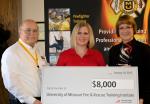COLUMBIA, Mo. – Beef producers faced calving challenges this winter due to historic cold weather. Producers and veterinarians reported that some cows simply lay down and gave up this winter when it came time to calve.
Dawna L. Voelkl, assistant teaching professor at the University of Missouri College of Veterinary Medicine, said there is no scientific research on how or if cold weather changes calving patterns. But reports from beef producers suggest that extreme cold weather interferes with the calving process.
Record snowfall and ice often prevented veterinarians from responding to calls, leaving producers trying to deliver calves from distressed cows on their own.
MU Extension responded by offering calving clinics statewide to help farmers protect their investments.
A “phantom uterus” is used to simulate techniques at calving clinics. A dead calf is used to provide a realistic demonstration of the many ways the farmer can assist the cow and unborn calf in delivery.
Voelkl said most births happen without assistance. A producer can recognize a cow is in distress if she separates from the main herd for eight to 12 hours without calving. The cow may lie down and appear to be colicky.
Normal births occur within two to four hours from the time the cow’s water breaks. The time for heifers is three to six hours. Intervention usually is required within two hours of the onset of this second stage of labor, after the first sac of the placenta ruptures, she said. Timing is critical.
Recognition of signs of distress to allow early intervention can increase the chances of survival for the calf, prevent postpartum problems and preserve the fertility of the cow.
Most births occur overnight or early in the morning, she said. To increase the likelihood of a daytime birth that is more convenient for producers, feed cows at night, as a full rumen can delay calving.
During the calving clinics, Voelkl explains general behaviors of cows preparing to give birth. She gives hints on how to tell if the unborn calf is alive and in normal position to deliver front feet and head first. She shows how to maneuver the head and feet of the calf manually if it is not oriented correctly.
Voelkl demonstrates how to remove the calf using chains, head snares, twine, eye hooks, lubrication and traction if there is evidence of death. She recommends methods to check for life since the calf might be in a hypoxic or comatose state. Additionally, she tells how to check for infection in the mother by examining the afterbirth and discharge.
Read more http://extension.missouri.edu/news/DisplayStory.aspx?N=2177





